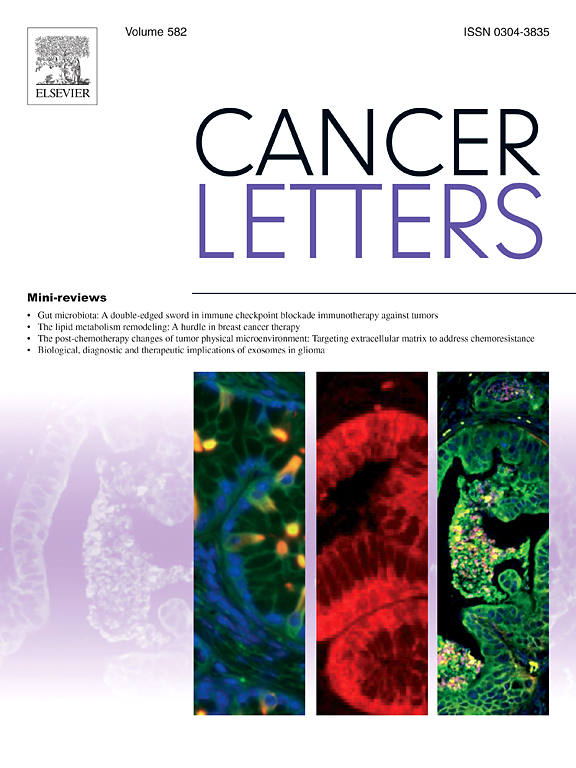Gain of chromosome 17 is an early genetic abnormality in neuroblastoma with PPM1D emerging as a strong candidate oncogene driving tumor progression
IF 9.1
1区 医学
Q1 ONCOLOGY
引用次数: 0
Abstract
Segmental gain of chromosome 17q is the most common genetic aberration in high-risk neuroblastoma, but its role in disease progression is poorly understood. This study aims to address the contribution of 17q gain to neuroblastoma malignancy.
We analyzed the genetic and transcriptional landscape of 417 neuroblastoma patients across various risk groups and clinical stages using multi-omic approaches. Single-cell RNA/DNA sequencing and SNP arrays were combined to characterize genomic aberrations, while evolutionary trajectories were mapped to explore the accumulation of genetic changes in patients with neuroblastoma. Additionally, DNA and RNA sequencing were used to assess mutational burden and gene expression patterns.
Our findings suggest that chromosome 17 gain is an early genetic event acquired during neuroblastoma development, correlating with the accumulation of additional chromosomal aberrations and poor prognosis. Increased segmental gains of chromosome 17q were observed during clonal evolution, relapse disease and metastasis. We identified PPM1D, a p53-inducible Ser/Thr phosphatase located on chr17q22.3, as a key player activated by segmental 17q-gain, gene-fusion, or gain-of-function somatic and germline mutations, further promoting neuroblastoma development/progression.
Gain of chromosome 17 is an early driver of genetic instability in neuroblastoma, with PPM1D emerging as a potential candidate gene implicated in high-risk disease progression.
17号染色体的增加是神经母细胞瘤的早期遗传异常,PPM1D成为驱动肿瘤进展的强有力的候选癌基因
染色体17q片段性增益是高危神经母细胞瘤中最常见的遗传畸变,但其在疾病进展中的作用尚不清楚。本研究旨在探讨17q增益在神经母细胞瘤恶性肿瘤中的作用。我们使用多组学方法分析了不同风险组和临床阶段的417名神经母细胞瘤患者的遗传和转录景观。单细胞RNA/DNA测序和SNP阵列相结合来表征基因组畸变,同时绘制进化轨迹以探索神经母细胞瘤患者遗传变化的积累。此外,DNA和RNA测序用于评估突变负担和基因表达模式。我们的研究结果表明,17号染色体的增加是神经母细胞瘤发展过程中获得的早期遗传事件,与额外染色体畸变的积累和不良预后相关。在克隆进化、疾病复发和转移过程中观察到17q染色体片段增益增加。我们发现PPM1D是一种p53诱导的丝氨酸/苏氨酸磷酸酶,位于chr17q22.3上,是17q片段获得、基因融合或功能获得的体细胞和种系突变激活的关键参与者,进一步促进神经母细胞瘤的发展/进展。17号染色体的增加是神经母细胞瘤遗传不稳定的早期驱动因素,PPM1D成为与高危疾病进展有关的潜在候选基因。
本文章由计算机程序翻译,如有差异,请以英文原文为准。
求助全文
约1分钟内获得全文
求助全文
来源期刊

Cancer letters
医学-肿瘤学
CiteScore
17.70
自引率
2.10%
发文量
427
审稿时长
15 days
期刊介绍:
Cancer Letters is a reputable international journal that serves as a platform for significant and original contributions in cancer research. The journal welcomes both full-length articles and Mini Reviews in the wide-ranging field of basic and translational oncology. Furthermore, it frequently presents Special Issues that shed light on current and topical areas in cancer research.
Cancer Letters is highly interested in various fundamental aspects that can cater to a diverse readership. These areas include the molecular genetics and cell biology of cancer, radiation biology, molecular pathology, hormones and cancer, viral oncology, metastasis, and chemoprevention. The journal actively focuses on experimental therapeutics, particularly the advancement of targeted therapies for personalized cancer medicine, such as metronomic chemotherapy.
By publishing groundbreaking research and promoting advancements in cancer treatments, Cancer Letters aims to actively contribute to the fight against cancer and the improvement of patient outcomes.
 求助内容:
求助内容: 应助结果提醒方式:
应助结果提醒方式:


